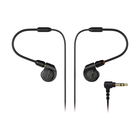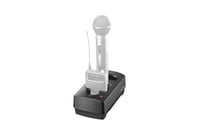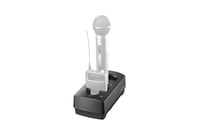An end-to-end solution for quality stage monitoring
System integrators, engineers, and performers alike are seeing (and hearing) the advantages of going wireless, not only for instruments and microphones but also for monitoring. Once a rare luxury, wireless in-ear monitor (IEM Definition:
Definition:
IEM (In-Ear Monitor): Earphones for musicians or announcers to hear program material, foldback, and IFB (Interrupt for Broadcast) audio. IEMs eliminate the need for listening to loudspeakers or monitor wedges. Often wireless.) systems have become increasingly common on stages everywhere – in venues, on tour, in broadcast applications, and in houses of worship.
The benefits of wireless guitar and mic transmitters are simple and obvious: no wires to limit the performer’s range of mobility. However, the advantages of wireless in-ear monitoring go deeper. When used properly, wireless IEMs can contribute to an overall better sound through the PA Definition:
Definition:
(Public Address) A sound system intended to provide audio coverage to large groups of people., allow for clearer live recordings, and even benefit the health and safety of performers!
A lot of different IEM systems can provide these benefits, but the 3000 Series from Audio-Technica does so with reliability, flexibility, and exceptional sound quality, right out of the box. This system shares many design elements with the successful 3000 Series instrument and microphone transmitters, completing a neatly integrated solution to any venue’s wireless needs.
Before we get into the details, though, it’s worthwhile to understand how wireless IEMs do a lot more than just keeping performers from tripping over cables.
How IEMs change the live experience
We’re all familiar with traditional stage monitors: speakers playing the mix back to the performers on stage, either from Front of House in a small venue or from a dedicated Definition:
Definition:
Designed or used to do a specific task or set of tasks. monitor mix in larger systems. These can be speaker wedges on the floor, small stand-mounted speakers, or sidestage monitor columns, but they all have the same issue – they’re blasting more audio onto a stage where there’s already plenty of audio flying around!
Here’s the problem. To reach the ears of a musician several feet away and still be heard over the band and the PA (and all the other monitors!), a monitor speaker has to be loud – and that loud signal goes everywhere, not just to the musician who needs it.
Stage monitors add to feedback Definition:
Definition:
1. A squealing, chirping, or ringing sound when a microphone feeding a loudspeaker picks up audio from that loudspeaker. Also called howlround. 2. The state where a device's output connects back to the input. problems, make it tricky to set up mics on certain instruments or amplifiers without bleed Definition:
Definition:
Sound or signal leaking into another track, cable or room., and interfere with what the audience is hearing from the PA. Worse still, in the “I need everything louder than everything else but especially more me” environment of a live show, monitors contribute to overall sound pressure levels (SPL) that can be punishingly loud, leading to irreparable hearing damage.
However, to reproduce audio in a very small space requires very little power – and your ear canals are very small spaces indeed! That means a good set of IEMs can put all the volume your ears can handle (and more) directly into your eardrums with a tiny power expenditure. Furthermore, if the IEMs are properly designed to seal tightly in your ear canals, you aren’t distracted by what’s going on all around you and nobody else can hear the monitor mix you’re hearing.
When the band uses wireless IEMs, suddenly everything changes. No more wedges means the only sound on stage is what the musicians themselves are creating. Microphones can be set up inside the throw of the PA without concern for other speakers on stage, with less bleed and overall better sound as a result. The musicians can hear exactly what they need to hear, whether it’s plenty of kick drum for the bass guitarist or “more me” for the lead vocalist, and they can hear it at a safe level to prevent hearing loss. Some musicians will always prefer wedges, but every set of IEMs on stage that replaces a monitor speaker will provide benefits for the band, the engineer, and the audience.
What makes a good wireless IEM system?
When a contractor or engineer sets up a stage rig Definition:
Definition:
A combination of equipment put together for a purpose. for wireless in-ear monitoring, there are certain strict criteria that need to be met.
First of all, the system needs to be flexible – the range of the frequency Definition:
Definition:
A value, expressed in Hertz, that indicates how many cycles of a periodic signal occur in one second. spectrum set aside for wireless audio has a lot of traffic, and it’s vital that each wireless system be able to select unused frequency bands with ease.
Second, the system should be scalable – it should be designed from the very beginning to allow more receivers and transmitters to be added easily and set up in such a way as to work smoothly with existing units.
Third, the system must be reliable – the signal must be clear and strong, free of distortion Definition:
Definition:
A change in an electronic or acoustic signal's waveform. This can undesirable if it impacts signal quality, or desirable when used for creative signal processing. and dropouts.
Finally, the system must be musical – for an artist to be inspired to play their best, what they’re hearing should be inspiring! It’s amazing how many cheap wireless systems treat sound quality as an afterthought.
Fortunately, Audio-Technica has all of these bases covered handily with the 3000 Series.
Everything you need
The 3000 Series IEM system comes as a package, the ATW-3255, which contains everything needed to set up one musician with a quality stereo Definition:
Definition:
A two channel signal simulating a sound space, typically played through two speakers. wireless monitor feed:
- The ATW-R3250 stereo receiver bodypack
- The ATW-T3205 rackmount/tabletop transmitter
 Definition:
Definition:
Any device that sends an electrical signal, typically radio waves or by wire. with included DC Definition:
Definition:
(Direct Current): Current that flows only in one direction, as opposed to AC (Alternating Current). Typically derived from batteries or DC power supplies. power adapter - A removable antenna
 Definition:
Definition:
A device for radiating or receiving electromagnetic signals. with a locking BNC connector Definition:
Definition:
(Bayonet-Nut Coupler) Connector: A twist-lock co-axial RF connector used for professional video, digital audio and antenna connections. - A rackmount kit for either a single ATW-T3205 unit or two of them side by side
- A set of Audio-Technica’s ATH-E40 in-ear monitors with an assortment of eartips
The package comes with a large, illustrated Quick Start Guide; the full User Manual is downloadable from the Audio-Technica website.
The R3250 is a compact and lightweight bodypack with a reversible belt clip, removable antenna, and only two exposed controls: a power/volume knob and a tiny Function button that displays current unit settings on the small but bright OLED Definition:
Definition:
(Organic Light Emitting Diode) A high-quality light-emitting display, based on organic compounds and not requiring a backlight (and therefore capable of creating true blacks), used in video and portable displays. display. A 3.5mm Definition:
Definition:
A popular, small audio connector. Used for many headphones and line-level stereo applications, as well as smartphones. TRS Definition:
Definition:
(Tip Ring Sleeve) Phone style connector. 3 conductor (Stereo) originally 1/4" diameter, also 1/8" and smaller and the TT style for patchbays. Used for headphones and patching. minijack on the top edge sends audio to the IEMs themselves, and is accompanied by a bright indicator LED Definition:
Definition:
LED (Light-Emitting Diode): A semiconductor light generator used in displays, television, pointers and for general illumination. It is a low-power replacement for incandescent lamps. – green for active, red for muted. A hinged cover opens to expose space for two AA batteries and controls for menu navigation (Up, Down, Back, Set) and activating IR Definition:
Definition:
(InfraRed) invisible light used for remote control devices and for IR wireless audio involving headsets and microphones. Sync Definition:
Definition:
To make two or more pieces of equipment or signals synchronize with each other. scanning.
Note that the R3250 bodypacks can be used with NiMH rechargeable batteries, which provide up to 7 hours of battery Definition:
Definition:
An assembly of series-wired cells that provides higher voltages than individual cells. life. This option is especially attractive to users of the 3000 Series wireless mic and instrument transmitters, as the IEM bodypacks use the same ATW-CHG3 and ATW-CHG3N charging stations – allowing for a complete wireless system to be kept at the ready at all times without redundant charging gear Definition:
Definition:
Musical or performance equipment..
The T3205 has stereo XLR inputs, stereo balanced 1/4” TRS loop outputs, and an Ethernet Definition:
Definition:
A local area network (LAN) using cables classified according to certain categories (CAT5, CAT6, CAT5e, etc.). These relate to the speed a cable can handle. port for connection to a Local Area Network (LAN Definition:
Definition:
LAN (Local Area Network): A collection of networked devices, in a single physical location such as an office building or home.). The latter becomes critical when running many IEMs at once and coordinating their settings using Audio-Technica’s Wireless Manager software. Front panel controls are simple: a push-turn encoder Definition:
Definition:
A device that converts an ordinary signal into a specifically modified signal in order to accomplish a specific purpose. Example: A rotary encoder on a digital signal processor converts control rotation into digital data. for data Definition:
Definition:
Information used by a computer in order to arrive at a decision. Although this is a plural term, it's often treated in the singular. and parameter adjustments, a Back button for menu navigation that you can hold down to turn off the RF Definition:
Definition:
(Radio Frequency) Electromagnetic radiation through the air, or electrical signals in cable. Typically, RF frequencies are above 100 kHz. broadcast and mute Definition:
Definition:
1. To silence or squelch an audio signal. 2. A switch that silences a signal. the receiver (its LED will turn red), and a power switch. The large, easy-to-read OLED screen is flanked by an IR Sync window to share settings with a receiver held close.
Up and running, scaling up
Getting started with the 3000 Series is easy. Just pop two AA batteries into the receiver, plug Definition:
Definition:
A connector, normally male and attached to a cable. in the transmitter and attach the antenna, plug two XLR cables with audio into the transmitter’s rear panel, connect your IEMs to the receiver, and turn everything on. If you’re using it on its own at first, it will come out of the box with the transmitter and receiver set to the same frequency – just turn up the volume and enjoy the music!
The receiver’s OLED can display bar graphs of signal levels – both radio frequency Definition:
Definition:
See: RF. (RF) strength and audio loudness Definition:
Definition:
1. An audio signal's perceived volume. 2. The quantifying of the ear's non-linear frequency response versus volume. See: Fletcher-Munson curve. – as well as current frequency, group and channel Definition:
Definition:
1. In radio, television, citizen's band radio, and other wireless communications modes, a specific frequency for communication. 2. In mixers and video, an input or output signal path with controls. 3. In MIDI, one of 16 data paths. settings, or a custom name for the receiver such as LEAD VOX or GUITAR1. Onboard settings include type of audio (stereo, mono/balanced, or a mix of multiple signals shared by several receivers), a limiter Definition:
Definition:
A form of compressor with a ratio of infinity:1 above the threshold for both overload protection, or as a sound effect to normalize volume. Some engineers consider a compressor with a ratio of 20:1 or higher above the threshold for a limiter. to protect your hearing, 2-band EQ, gain Definition:
Definition:
The amount of amplification provided by an amplifier circuit, expressed in dB or numerically as in "3X" = "3 times". adjustment, and more.
Settings can be quickly shared between receiver and transmitter using the built-in IR Sync system, and multiple units can be set up with their own frequencies, groups, and channels. This can be done manually or via the Wireless Manager software, making the addition of new monitors easy as the system grows. The system covers a wide frequency range: 470 to 608 MHz Definition:
Definition:
Abbreviation for Megahertz. 1,000,000 Hertz, or one million cycles per second., with frequency settings as fine as 0.025 MHz. Multiple complete sets of receiver settings – frequency, name, group, channel, etc. – can be stored as Cue Definition:
Definition:
1. (verb) Monitoring and getting a program event ready to go, or direction to talent to commence a program or portion of a program. 2. (noun) A particular piece of music in a video, film, or TV score associated with a particular on-screen event. Mode presets for fast switching between different wireless systems.
On the other end
While most wireless IEM systems will include a set of inexpensive earbuds, it’s worth noting that the 3000 Series package comes with Audio-Technica’s popular ATH-E40 IEMs. These are excellent-sounding and highly isolating IEMs with dual phase Definition:
Definition:
Sound waves are variations in air pressure that, like water waves, have peaks and troughs. Phase is the waveform's position in its current cycle. For example, if two versions of the same waveform are both at their peak, or at their trough, they're considered in phase. If one is at its peak and one is at its trough, they are considered out of phase. If one is at its peak and the other is at zero (between the peak and trough), then the two waveforms are 90 degrees out of phase. See also: Polarity push-pull drivers, delivering absolutely superb sound as a part of the package. They even come with their own zippered hard case for travel, and the cable can be detached from the earpieces and replaced easily in case of wear.
Total satisfaction
Our tests with the 3000 Series IEM system were an utter delight. System setup was a breeze, signal strength was strong and steady despite our best attempts to cause problems with distance or obstacles, and the sound quality was exquisite – both through the included ATH-E40 IEMs and our high-end custom monitors.
Audio-Technica makes a compelling statement with the 3000 Series IEM system, following up on the excellent 3000 Series wireless transmitters with an equally impressive monitoring solution. Regardless of installation size, this system will provide future-proof performance for years to come, with fantastic sound as part of the package.
















